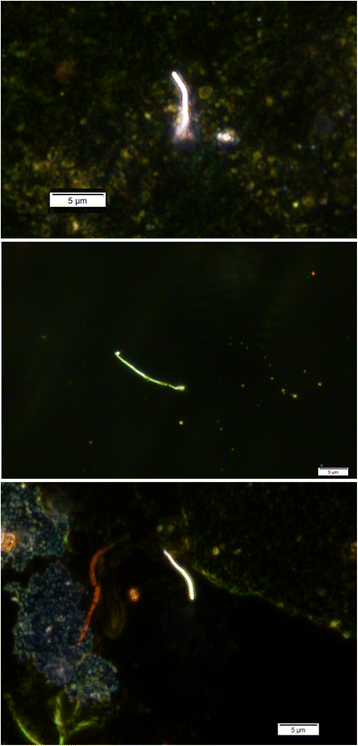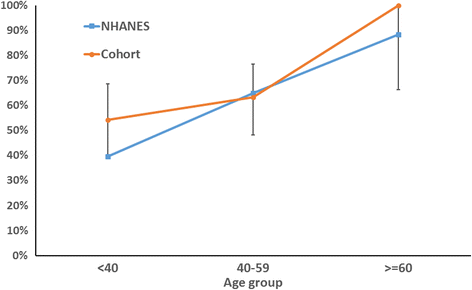Association of pulmonary, cardiovascular, and hematologic metrics with carbon nanotube and nanofiber exposure among U.S. workers: a cross-sectional study
- PMID: 29769147
- PMCID: PMC5956815
- DOI: 10.1186/s12989-018-0258-0
Association of pulmonary, cardiovascular, and hematologic metrics with carbon nanotube and nanofiber exposure among U.S. workers: a cross-sectional study
Abstract
Background: Commercial use of carbon nanotubes and nanofibers (CNT/F) in composites and electronics is increasing; however, little is known about health effects among workers. We conducted a cross-sectional study among 108 workers at 12 U.S. CNT/F facilities. We evaluated chest symptoms or respiratory allergies since starting work with CNT/F, lung function, resting blood pressure (BP), resting heart rate (RHR), and complete blood count (CBC) components.
Methods: We conducted multi-day, full-shift sampling to measure background-corrected elemental carbon (EC) and CNT/F structure count concentrations, and collected induced sputum to measure CNT/F in the respiratory tract. We measured (nonspecific) fine and ultrafine particulate matter mass and count concentrations. Concurrently, we conducted physical examinations, BP measurement, and spirometry, and collected whole blood. We evaluated associations between exposures and health measures, adjusting for confounders related to lifestyle and other occupational exposures.
Results: CNT/F air concentrations were generally low, while 18% of participants had evidence of CNT/F in sputum. Respiratory allergy development was positively associated with inhalable EC (p=0.040) and number of years worked with CNT/F (p=0.008). No exposures were associated with spirometry-based metrics or pulmonary symptoms, nor were CNT/F-specific metrics related to BP or most CBC components. Systolic BP was positively associated with fine particulate matter (p-values: 0.015-0.054). RHR was positively associated with EC, at both the respirable (p=0.0074) and inhalable (p=0.0026) size fractions. Hematocrit was positively associated with the log of CNT/F structure counts (p=0.043).
Conclusions: Most health measures were not associated with CNT/F. The positive associations between CNT/F exposure and respiratory allergies, RHR, and hematocrit counts may not be causal and require examination in other studies.
Keywords: Advanced manufacturing; Blood pressure; Epidemiology; Heart rate; Nanomaterials; Nanotoxicology; Occupational; Pulmonary function.
Conflict of interest statement
Ethics approval and consent to participate
The Institutional Review Board of the National Institute for Occupational Safety and Health approved the protocol (#12-DSHEFS-05XP), and written informed consent was obtained from all participants.
Competing interests
The authors declare that they have no competing interests.
Publisher’s Note
Springer Nature remains neutral with regard to jurisdictional claims in published maps and institutional affiliations.
Figures


Similar articles
-
Association of occupational exposures with ex vivo functional immune response in workers handling carbon nanotubes and nanofibers.Nanotoxicology. 2020 Apr;14(3):404-419. doi: 10.1080/17435390.2020.1717007. Epub 2020 Feb 7. Nanotoxicology. 2020. PMID: 32031476 Free PMC article.
-
Carbon nanotube and nanofiber exposure and sputum and blood biomarkers of early effect among U.S. workers.Environ Int. 2018 Jul;116:214-228. doi: 10.1016/j.envint.2018.04.004. Epub 2018 Apr 23. Environ Int. 2018. PMID: 29698898 Free PMC article.
-
Exposure assessments for a cross-sectional epidemiologic study of US carbon nanotube and nanofiber workers.Int J Hyg Environ Health. 2018 Apr;221(3):429-440. doi: 10.1016/j.ijheh.2018.01.006. Epub 2018 Jan 11. Int J Hyg Environ Health. 2018. PMID: 29339022
-
A review of carbon nanotube toxicity and assessment of potential occupational and environmental health risks.Crit Rev Toxicol. 2006 Mar;36(3):189-217. doi: 10.1080/10408440600570233. Crit Rev Toxicol. 2006. PMID: 16686422 Review.
-
Human exposure to carbon-based fibrous nanomaterials: A review.Int J Hyg Environ Health. 2016 Mar;219(2):166-75. doi: 10.1016/j.ijheh.2015.12.005. Epub 2015 Dec 23. Int J Hyg Environ Health. 2016. PMID: 26752069 Review.
Cited by
-
Toxicity of Carbon-Based Nanomaterials in the Human Lung: A Comparative In-Vitro Study.Tanaffos. 2022 Mar;21(3):391-400. Tanaffos. 2022. PMID: 37025312 Free PMC article.
-
Evaluation of total and inhalable samplers for the collection of carbon nanotube and carbon nanofiber aerosols.Aerosol Sci Technol. 2019;53(8):958-970. doi: 10.1080/02786826.2019.1618437. Epub 2019 May 30. Aerosol Sci Technol. 2019. PMID: 35392279 Free PMC article.
-
Occupational Exposure to Carbon Nanotubes and Carbon Nanofibres: More Than a Cobweb.Nanomaterials (Basel). 2021 Mar 16;11(3):745. doi: 10.3390/nano11030745. Nanomaterials (Basel). 2021. PMID: 33809629 Free PMC article. Review.
-
Current state of knowledge on the health effects of engineered nanomaterials in workers: a systematic review of human studies and epidemiological investigations.Scand J Work Environ Health. 2019 May 1;45(3):217-238. doi: 10.5271/sjweh.3800. Epub 2019 Jan 17. Scand J Work Environ Health. 2019. PMID: 30653633 Free PMC article.
-
Predicting Occupational Exposures to Carbon Nanotubes and Nanofibers Based on Workplace Determinants Modeling.Ann Work Expo Health. 2019 Feb 16;63(2):158-172. doi: 10.1093/annweh/wxy102. Ann Work Expo Health. 2019. PMID: 30715150 Free PMC article.
References
Publication types
MeSH terms
Substances
Grants and funding
LinkOut - more resources
Full Text Sources
Other Literature Sources
Medical
Molecular Biology Databases

